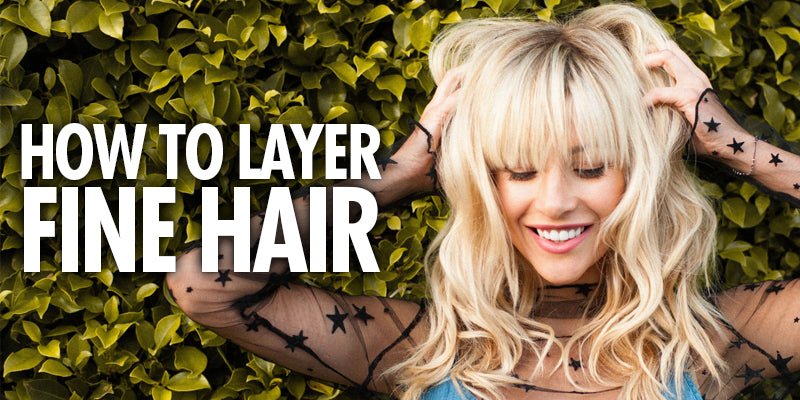WHAT ARE THE CHALLENGES WE FACE WHEN CUTTING HAIR?
There are many common challenges hairdressers face while cutting hair, one of the most common is executing the precision required for a straight and concise line across the ends of the hair.
The most popular in-salon haircuts such as one-length cuts, bobs and lobs require precise, solid edges. The most common concerns from stylists are inconsistency and unwanted graduation at the ends, discovered once the hair is blown dry.
Fortunately, Andrew Carruthers, Cultural Ambassador for Sam Villa is here to break down common bad habits and concerns within haircutting that challenge our ability to cut straight lines, along with the solutions to become an expert in precision cutting!
WHY IS IT CHALLENGING TO CUT HAIR STRAIGHT?
Challenge #1
- The common way we cut hair at the perimeter is by clamping the hair in between our pointer and middle fingers at the ends, then cutting along the bottom of our fingers. Cutting hair this way, we use our fingers as a guide to cut the ends in a straight line. This challenges us because while clamping the ends of the hair with our fingers, we tend to elevate the ends upward and away from natural fall, causing elevation and unwanted graduation at the ends.
- This also becomes challenging when trying to find your guide for your next section as graduation creates a slight difference in the length within each section. (The hair will be slightly longer in the back of the section than in the front of the section).
Challenge #2
- Another challenge we face when cutting hair is our inability to be eye level to the cutting line. Most salon chairs place our clients low which is why we tend to flip our fingers up towards us when cutting, bending the hair out of natural position. This also creates unwanted graduation at the ends.
Challenge #3
- The third challenge occurs when we are cutting to connect our guidelines from section to section. When cutting a new section of hair to mirror the guideline, the natural tendency is to use our fingers as the bridge from the ends of the new section to the previously cut guideline. Once the fingers are aligned with the guideline, we cut the hair across for a solid line.
- The challenge arises when we align the fingertips to the guideline, then cut below the fingers. By doing this, the hair is cut to the top edge of the previously cut section versus the bottom edge. This is due to misjudging the thickness of our fingers resulting in inconsistent lengths.
An important note to remember is the further we get up to the crown of the head, the more the hair will swell up as it dries. This is a key point to be aware of while you move up the head shape during your haircut.
WHAT ARE THE SOLUTIONS TO THESE COMMON HAIRCUTTING CHALLENGES?
There are a few simple solutions to conquer the common challenges explained above. By slightly altering our everyday haircutting habits, we can master the art of precision and avoid these potential challenges happening in the future!
Solution #1 and #2
When cutting your guide, rather than placing your fingers into the section and clamping the ends, use your comb to guide your fingers.
- Comb the hair from the root into natural fall, following the bottom of the comb with your fingers – this prevents graduation.
- Guide your fingers using the comb until you reach your desired cutting length. Then, cut your guide. This will ensure the ends are in line with natural fall and you achieve a clean, straight edge.
Solution #3
When connecting your guidelines from section to section, rather than aligning your fingertips to the top edge of your previously cut section, align your fingers with the bottom edge (or slightly below it).
- Once your fingertips are aligned to the bottom edge, bring in your shears and cut to mirror your previous guideline.
- This will ensure a consistent length across the entire bottom edges.
- Each section may appear slightly longer. This is okay! When it’s blown dry, you’ll see the precision across.
- This can happen due to the swelling of the hair where the change in direction occurs, as you move up the head towards the crown.
Hot tip!
An overall solution is to keep the hands out of the hair! Introduce your comb in place of your fingers.
- Comb the hair starting from the roots down to the ends, following the hairs’ natural fall.
- Stop the comb at your desired cutting guide.
- Hold your comb steady and bring your blades up to the comb, in a parallel position.
- Cut the hair by gliding your shears blades across the comb.
- This will allow for less tension and the ability to keep the hair at it’s natural fall position from section to section.
When you’re cutting your next haircut that requires precision, and you’re fearful of losing control, try this technique!
FINAL WORDS
The most important things to remember when cutting for precision are to keep your fingers flat and always aligned with natural fall, and when in doubt, use your comb in place of your fingers!
There are several haircut trends within our industry such as A-symmetrical cuts, V-shapes, and rounded edges. Being grounded in the principles to achieve precision will enhance your skill set to master every trend!
We hope that these solutions will help bring your cutting skills to the next level.
Recommended Shears For This Technique
Related Blog Posts:








